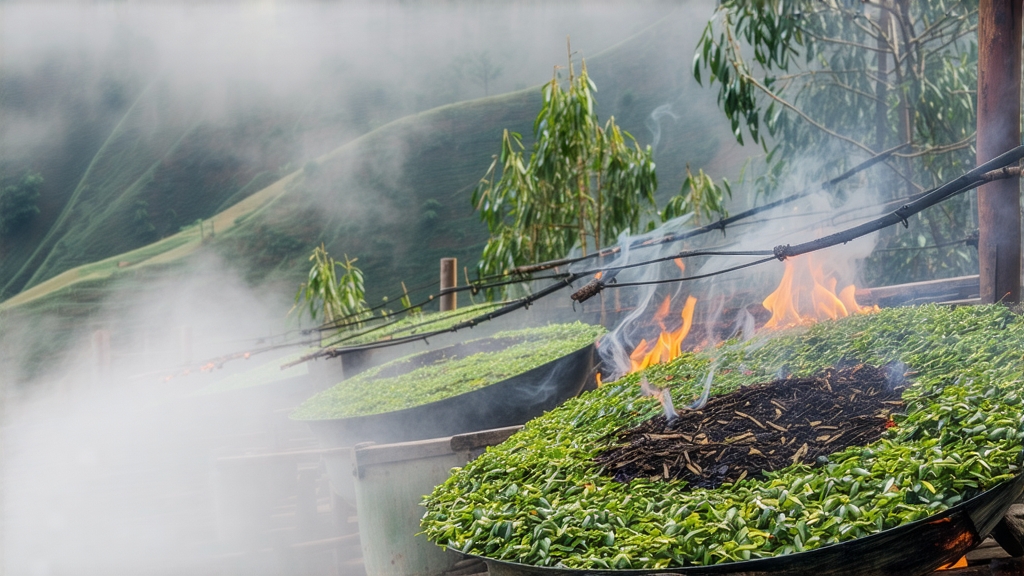
Long before English breakfast blends and Assam malts filled porcelain cups, a single tea left the granite gorges of northern Fujian and astonished the docks of Amsterdam and London. That tea was Lapsang Souchong—today celebrated as the first fully oxidised black tea ever created, the prototype that launched the entire category Westerners still call “black” while the Chinese know it as hong cha, “red tea.” Its story is one of military accident, pine-resin ingenuity, and trans-continental longing for flavour so vivid it could survive months at sea and still perfume a drawing room.
Historical roots
The Wuyi Mountains, a UNESCO dual heritage site, rise in steep, fog-laden folds where nine rivers cut through volcanic rock. Monks and literati had grown tea here since the Song dynasty, but the earliest written record of Lapsang Souchong appears in 1646, during the Qing transition. Local lore claims that passing Qing troops commandeered a tea factory; to dry the leaves quickly before marching on, workers spread them over fresh pine fires. The smoke penetrated the leaf, the colour turned ebony, and the flavour—resinous, fruity, almost wine-like—proved irresistible to the Dutch traders who first carried it to Europe. By 1669 the British East India Company listed “Bohea Souchong” among its most valuable cargoes, priced above silver and silks. The name itself is a Mandarin-Cantonese hybrid: “Xiao Zhong” means “small cultivar,” while “Lapsang” derives from the local Fuzhou dialect for “pine mountain.” Thus the tea became a geographic and linguistic bridge between Chinese terroir and Western imagination.
Micro-terroirs and leaf grades
Within the 60-kilometre core zone recognised for original Lapsang production, three micro-terroirs produce distinctly different styles. Tongmu Guan, the highest and most restricted, sits at 1 200 m where nocturnal temperatures drop 15 °C, encouraging slow growth and a high concentration of floral volatiles. Leaves from here are plucked with the classic “two and a bud” standard but only in the brief late-May window just before the Grain Rain; they yield the celebrated “Zheng Shan Xiao Zhong,” unsmoked and exquisitely honeyed. Lower valleys such as Xingcun and Muta produce the traditional smoked version, using the larger late-season leaves that better absorb pine aroma without becoming acrid. Finally, outside the Wuyi reserve, leaf from neighbouring counties is marketed as “Wuyi-style” Souchong; while pleasant, it lacks the mineral backbone imparted by the original granite soil and fluctuating mountain mist.
Crafting the smoke: an alchemy of wood, air and time
Authentic production follows a 400-year-old sequence that begins with withering on bamboo screens set high inside the three-storey Tongmu factories. Here, mountain breeze replaces mechanical fans; 60 % moisture is lost over eight hours while enzymes start converting leaf sugars into aromatic precursors. Next comes rolling, once done by barefoot treading but now by slow-speed brass machines that mimic hand pressure, rupturing cells without overheating. Oxidation occurs in cedar-lined trays kept at 24 °C and 85 % humidity; the leaf reddens evenly in ninety minutes, shorter than for most black teas to preserve forthcoming smoke balance. The critical stage is the final drying over pine embers. Craftspeople use 40-year-old Massoniana trunks split into arm-length staves; resin pockets are richest near the heartwood, so only the centre cuts are laid into a long, shallow pit. Temperature is held below 80 °C so the leaf desiccates rather than bakes, absorbing alpha-pinene and bornyl acetate molecules that later translate into notes of smoked apricot and camphor. A single batch is smoked three times, each cycle separated by 24-hour rest periods during which the leaf re-absorbs ambient moisture, allowing deeper aroma penetration. The entire process consumes five days and one kilogram of finished tea requires 4.5 kg of fresh leaf and 2 kg of pine wood—an extravagant ratio that explains both cost and rarity.
Unsmoked versus smoked: a modern divergence
In the 1970s Japanese and German importers requested a “clean” version free of smoke for fear of pesticide residues in pine. Tongmu farmers responded by drying the leaf over hot air conducted through